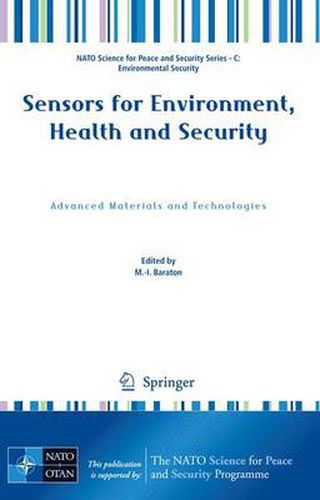Readings Newsletter
Become a Readings Member to make your shopping experience even easier.
Sign in or sign up for free!
You’re not far away from qualifying for FREE standard shipping within Australia
You’ve qualified for FREE standard shipping within Australia
The cart is loading…






This title is printed to order. This book may have been self-published. If so, we cannot guarantee the quality of the content. In the main most books will have gone through the editing process however some may not. We therefore suggest that you be aware of this before ordering this book. If in doubt check either the author or publisher’s details as we are unable to accept any returns unless they are faulty. Please contact us if you have any questions.
The NATO Advanced Study Institute on Sensors for Environment, Health and Security: Advanced Materials and Technology was held in Vichy (France) on September 16-27, 2007 where more than 65 participants, ranging from Ph. D. students to experienced senior scientists, met and exchanged ideas and know-how in a friendly atmosphere. The present book intends to cover the main topics of this NATO ASI through 32 chapters distributed over two parts (Part I: Materials and Technologies and Part II: Applications to Environment, Health and Security ). The scientific programme of the NATO ASI consisted in 28 1-hour lectures given by 14 invited lecturers, 5 additional 1-hour lectures given by seminar speakers, 22 oral presentations by selected ASI participants and a poster session. The programme was divided into four sessions: (1) Advanced materials and technologies; (2) Sensors for environment; (3) Sensors for health; (4) Sensors for security. During the Advanced Materials and Technologies session (Part I of the present book), the lectures were dedicated to critical analyses of current methods for the synthesis of materials, nanomaterials (nanoparticles, nanowires, nanotubes, …) and nanocomposites to be used for the fabrication of sensing devices, mainly semiconductor sensors. Among the synthesis methods, chemical (sol-gel, etc. ) and physical methods (laser deposition, DC magnetron sputtering, etc. ) were discussed. Several lectures addressed characterization techniques and it was concluded that the physical and chemical control of the materials/nanomaterials, including surface chemistry, remains a key issue for the reproducibility of the final device.
$9.00 standard shipping within Australia
FREE standard shipping within Australia for orders over $100.00
Express & International shipping calculated at checkout
This title is printed to order. This book may have been self-published. If so, we cannot guarantee the quality of the content. In the main most books will have gone through the editing process however some may not. We therefore suggest that you be aware of this before ordering this book. If in doubt check either the author or publisher’s details as we are unable to accept any returns unless they are faulty. Please contact us if you have any questions.
The NATO Advanced Study Institute on Sensors for Environment, Health and Security: Advanced Materials and Technology was held in Vichy (France) on September 16-27, 2007 where more than 65 participants, ranging from Ph. D. students to experienced senior scientists, met and exchanged ideas and know-how in a friendly atmosphere. The present book intends to cover the main topics of this NATO ASI through 32 chapters distributed over two parts (Part I: Materials and Technologies and Part II: Applications to Environment, Health and Security ). The scientific programme of the NATO ASI consisted in 28 1-hour lectures given by 14 invited lecturers, 5 additional 1-hour lectures given by seminar speakers, 22 oral presentations by selected ASI participants and a poster session. The programme was divided into four sessions: (1) Advanced materials and technologies; (2) Sensors for environment; (3) Sensors for health; (4) Sensors for security. During the Advanced Materials and Technologies session (Part I of the present book), the lectures were dedicated to critical analyses of current methods for the synthesis of materials, nanomaterials (nanoparticles, nanowires, nanotubes, …) and nanocomposites to be used for the fabrication of sensing devices, mainly semiconductor sensors. Among the synthesis methods, chemical (sol-gel, etc. ) and physical methods (laser deposition, DC magnetron sputtering, etc. ) were discussed. Several lectures addressed characterization techniques and it was concluded that the physical and chemical control of the materials/nanomaterials, including surface chemistry, remains a key issue for the reproducibility of the final device.